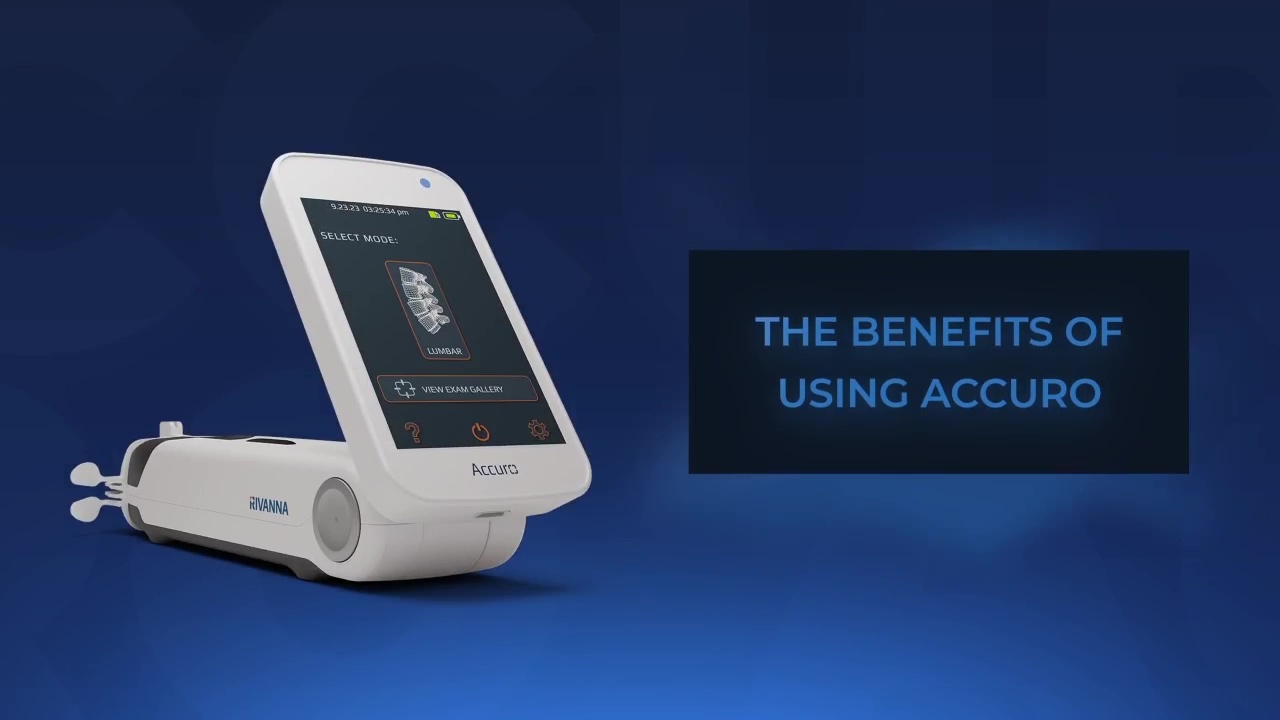Accuro Neuraxial Anesthesia Guidance
Anesthesia Providers: Choose Accuro Neuraxial Guidance for automated landmark identification. Experience faster, safer, and easier epidurals, and take control of positive patient outcomes. Pricing starts at $2,995 USD. No cloud subscription required.

Accuro: Clinically Proven Neuraxial Guidance
%
HIGHER first-insertion success rates
%
FEWER paresthesia instances (even for experienced providers)
%
REDUCTION in patients who reported patient satisfaction of less than 4 on a 5-point scale.
Ultrasound Simplified: Pinpoint key neuraxial targets, including the interlaminar space and depth, using Accuro’s AI-enabled image guidance and unique bone-imaging technology. Clinically proven to improve first-attempt success rates, especially in patients with complex anatomy, Accuro’s effectiveness surpasses traditional ‘blind’ palpation methods, regardless of provider experience, the type of neuraxial anesthesia, or previous Accuro training.
Enhance Patient Safety and Clinical Efficiency
More than 3.5 million neuraxial anesthesia procedures are performed annually in the U.S., primarily in the labor and delivery department. With needle placement failure rates ranging from 20% to 80% — largely based on clinician skill, patient BMI, and age — complications such as repeated attempts, long-term pain, and even paralysis in rare yet devastating cases are significant concerns.
CHALLENGES
%
reported first-attempt failure rates using palpation in obese patients.
ULTRASOUND
%
higher first-attempt success rates reported with pre-procedural ultrasound.
LIMITATIONS
%
competence levels reported for interspace identification with ultrasound.
SOLUTIONS
%
increase in first-attempt success rates reported with Accuro.
About Us
Founded in 2010 by University of Virginia graduate students, our co-founder was driven by a compelling problem statement: to dramatically reduce the high failure rates of epidural and spinal anesthesia placements with optimized ultrasound technology. This enduring commitment to addressing unexplored healthcare challenges has propelled RIVANNA to become a leader in medical imaging technology, continuously innovating to meet unmet clinical needs and improve healthcare delivery.
75+ Global Patents & Patents Pending
$59M DHHS Awards to Date

200+ Hospitals

5 Continents
Real-World Accuro Success Stories
“Accuro is a game changer… I use it now in all my procedures and to train our residents. Not only are we improving our first-attempt success rates with Accuro, but we are also noticing a reduction in back pain and wet taps. By improving efficiency and reducing risk, we are greatly improving the standard of care we provide to our patients.”
“A morbidly obese patient had two difficult epidural placements by other anesthesia providers. Both epidurals failed after six hours… I utilized the Accuro device and placed a working CSE within five minutes…Both the surgeon and patient were pleased. It was a fabulous example of the need for the device.”
Accuro Use Cases: From Challenge to Triumph.
Patients with above-normal BMI face a higher risk of epidural failure due to less apparent spinal bony structures. Additionally, those with atypical spinal conditions, such as scoliosis or prior surgeries, also face significant risk. Learn how Accuro delivers results for patients with challenging anatomy.
Morbid Obesity: 160 kg and BMI of 60
Dr. Launius highlighted that Accuro provided crucial data; he swiftly achieved loss of resistance and successfully placed the epidural catheter on the first attempt.
Spinal Hardware & Significant Compression
Stephen Garber, MD, an Anesthesiologist at Saddleback Medical Center, used Accuro to facilitate midline and intervertebral space detection for a successful epidural placement during L&D.
Scoliosis with Significant Intravertebral Rotation
RIVANNA’s Role in Modern Healthcare
Bridging Gaps
Our proprietary technology solutions address unmet clinical needs across a wide array of clinical indications within government, industry, and clinical settings to provide simple, cost-effective alternatives to the existing standard of care.
Elevating Standards
Our advantage stems from integrating bone-specific ultrasound technology with AI-enabled software. This combination delivers a comprehensive imaging-based solution that improves patient safety through radiation-free alternatives and increases provider precision and efficiency with integrated clinician support.
Effective Change
Collaboration is vital in the healthcare marketplace to develop solutions that advance our healthcare landscape. RIVANNA’s participation in conferences and contributions to medical literature drive meaningful engagement and transformative change for our partners in the field.
Get the Accuro advantage.
Recent Insights

The Essential Role of Ultrasound in Neuraxial Anesthesia
Dr. Brendan Carvalho shares insights from a study comparing Accuro’s accuracy to other ultrasound devices for neuraxial anesthesia. He explains how both Accuro and larger ultrasound systems reliably predict the point of loss of resistance, particularly in patients with challenging anatomy, such as those with obesity, scoliosis, or previous spine surgery. Dr. Carvalho highlights Accuro’s key advantages, including its portability, 3D navigation, and unique skin-marking feature, which together enhance precision and usability in both clinical and teaching environments.

Key Benefits of Accuro for Epidural Success
Beth Clayton, DNP, MS, CRNA, Nurse Anesthesia Program Director, University of Cincinnati
Program Director Beth Clayton explains how Accuro improves epidural efficacy, reduces complications, and enhances the overall patient experience.

What Are the Benefits of Using Accuro?
What are the benefits of using Accuro? Dr. Beth Clayton, nurse anesthesia program director at the University of Cincinnati, explains how Accuro facilitates a more effective epidural, lowers complication rates, and optimizes the patient experience. We invite you to...
Performance claims: A. Macario et al. (2000); M. Tiouririne et al. (2017); Singla et al. (2019); D. Ghisi et al. (2019); Ni, X., Li, Mz., Zhou, Sq. et al.